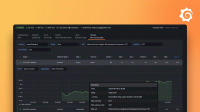Caution
Grafana Alloy is the new name for our distribution of the OTel collector. Grafana Agent has been deprecated and is in Long-Term Support (LTS) through October 31, 2025. Grafana Agent will reach an End-of-Life (EOL) on November 1, 2025. Read more about why we recommend migrating to Grafana Alloy.
The run command
The run command runs Grafana Agent Flow in the foreground until an interrupt is received.
Usage
Usage:
AGENT_MODE=flow grafana-agent run [FLAG ...] PATH_NAMEgrafana-agent-flow run [FLAG ...] PATH_NAMEReplace the following:
FLAG: One or more flags that define the input and output of the command.PATH_NAME: Required. The Grafana Agent Flow configuration file/directory path.
If the PATH_NAME argument is not provided, or if the configuration path can’t be loaded or
contains errors during the initial load, the run command will immediately exit and show an error message.
If you give the PATH_NAME argument a directory path, Grafana Agent Flow will find *.river files
(ignoring nested directories) and load them as a single configuration source. However, component names must
be unique across all River files, and configuration blocks must not be repeated.
Grafana Agent Flow will continue to run if subsequent reloads of the configuration file fail, potentially marking components as unhealthy depending on the nature of the failure. When this happens, Grafana Agent Flow will continue functioning in the last valid state.
run launches an HTTP server that exposes metrics about itself and its
components. The HTTP server is also exposes a UI at / for debugging
running components.
The following flags are supported:
--server.http.enable-pprof: Enable /debug/pprof profiling endpoints. (defaulttrue)--server.http.memory-addr: Address to listen for in-memory HTTP traffic on (defaultagent.internal:12345).--server.http.listen-addr: Address to listen for HTTP traffic on (default127.0.0.1:12345).--server.http.ui-path-prefix: Base path where the UI is exposed (default/).--storage.path: Base directory where components can store data (defaultdata-agent/).--disable-reporting: Disable data collection (defaultfalse).--cluster.enabled: Start Grafana Agent Flow in clustered mode (defaultfalse).--cluster.node-name: The name to use for this node (defaults to the environment’s hostname).--cluster.join-addresses: Comma-separated list of addresses to join the cluster at (default""). Mutually exclusive with--cluster.discover-peers.--cluster.discover-peers: List of key-value tuples for discovering peers (default""). Mutually exclusive with--cluster.join-addresses.--cluster.rejoin-interval: How often to rejoin the list of peers (default"60s").--cluster.advertise-address: Address to advertise to other cluster nodes (default"").--cluster.advertise-interfaces: List of interfaces used to infer an address to advertise. Set toallto use all available network interfaces on the system. (default"eth0,en0").--cluster.max-join-peers: Number of peers to join from the discovered set (default5).--cluster.name: Name to prevent nodes without this identifier from joining the cluster (default"").--config.format: The format of the source file. Supported formats:flow,otelcol,prometheus,promtail,static(default"flow").--config.bypass-conversion-errors: Enable bypassing errors when converting (defaultfalse).--config.extra-args: Extra arguments from the original format used by the converter.
Update the configuration file
The configuration file can be reloaded from disk by either:
- Sending an HTTP POST request to the
/-/reloadendpoint. - Sending a
SIGHUPsignal to the Grafana Agent Flow process.
When this happens, the component controller synchronizes the set of running components with the latest set of components specified in the configuration file. Components that are no longer defined in the configuration file after reloading are shut down, and components that have been added to the configuration file since the previous reload are created.
All components managed by the component controller are reevaluated after reloading.
Clustering
The --cluster.enabled command-line argument starts Grafana Agent in
clustering mode. The rest of the --cluster.* command-line flags can be
used to configure how nodes discover and connect to one another.
Each cluster member’s name must be unique within the cluster. Nodes which try to join with a conflicting name are rejected and will fall back to bootstrapping a new cluster of their own.
Peers communicate over HTTP/2 on the built-in HTTP server. Each node
must be configured to accept connections on --server.http.listen-addr and the
address defined or inferred in --cluster.advertise-address.
If the --cluster.advertise-address flag isn’t explicitly set, Grafana Agent Flow
tries to infer a suitable one from --cluster.advertise-interfaces.
If --cluster.advertise-interfaces isn’t explicitly set, Grafana Agent Flow will
infer one from the eth0 and en0 local network interfaces.
Grafana Agent Flow will fail to start if it can’t determine the advertised address.
Since Windows doesn’t use the interface names eth0 or en0, Windows users must explicitly pass
at least one valid network interface for --cluster.advertise-interfaces or a value for --cluster.advertise-address.
The comma-separated list of addresses provided in --cluster.join-addresses
can either be IP addresses with an optional port, or DNS records to lookup.
The ports on the list of addresses default to the port used for the HTTP
listener if not explicitly provided. We recommend that you
align the port numbers on as many nodes as possible to simplify the deployment
process.
The --cluster.discover-peers command-line flag expects a list of tuples in
the form of provider=XXX key=val key=val .... Clustering uses the
go-discover package to discover peers and fetch their IP addresses, based
on the chosen provider and the filtering key-values it supports. Clustering
supports the default set of providers available in go-discover and registers
the k8s provider on top.
If either the key or the value in a tuple pair contains a space, a backslash, or double quotes, then it must be quoted with double quotes. Within this quoted string, the backslash can be used to escape double quotes or the backslash itself.
The --cluster.rejoin-interval flag defines how often each node should
rediscover peers based on the contents of the --cluster.join-addresses and
--cluster.discover-peers flags and try to rejoin them. This operation
is useful for addressing split-brain issues if the initial bootstrap is
unsuccessful and for making clustering easier to manage in dynamic
environments. To disable this behavior, set the --cluster.rejoin-interval
flag to "0s".
Discovering peers using the --cluster.join-addresses and
--cluster.discover-peers flags only happens on startup; after that, cluster
nodes depend on gossiping messages with each other to converge on the cluster’s
state.
The first node that is used to bootstrap a new cluster (also known as the “seed node”) can either omit the flags that specify peers to join or can try to connect to itself.
To join or rejoin a cluster, Grafana Agent Flow will try to connect to a certain number of peers limited by the --cluster.max-join-peers flag.
This flag can be useful for clusters of significant sizes because connecting to a high number of peers can be an expensive operation.
To disable this behavior, set the --cluster.max-join-peers flag to 0.
If the value of --cluster.max-join-peers is higher than the number of peers discovered, Grafana Agent Flow will connect to all of them.
The --cluster.name flag can be used to prevent clusters from accidentally merging.
When --cluster.name is provided, nodes will only join peers who share the same cluster name value.
By default, the cluster name is empty, and any node that doesn’t set the flag can join.
Attempting to join a cluster with a wrong --cluster.name will result in a “failed to join memberlist” error.
Clustering states
Clustered Grafana Agents are in one of three states:
Viewer: Grafana Agent Flow has a read-only view of the cluster and isn’t participating in workload distribution.
Participant: Grafana Agent Flow is participating in workload distribution for components that have clustering enabled.
Terminating: Grafana Agent Flow is shutting down and will no longer assign new work to itself.
Each Grafana Agent initially joins the cluster in the viewer state and then transitions to the participant state after the process startup completes. Each Grafana Agent then transitions to the terminating state when shutting down.
The current state of a clustered Grafana Agent is shown on the clustering page in the UI.
Configuration conversion (beta)
When you use the --config.format command-line argument with a value
other than flow, Grafana Agent converts the configuration file from
the source format to River and immediately starts running with the new
configuration. This conversion uses the converter API described in the
grafana-agent-flow convert docs.
If you include the --config.bypass-conversion-errors command-line argument,
Grafana Agent Flow will ignore any errors from the converter. Use this argument
with caution because the resulting conversion may not be equivalent to the
original configuration.
Include --config.extra-args to pass additional command line flags from the original format to the converter.
Refer to grafana-agent-flow convert for more details on how extra-args work.



